DOTS: A Solution for Tuberculosis
VerifiedAdded on 2020/05/28
|6
|1464
|300
AI Summary
This assignment examines the benefits of Directly Observed Treatment, Short Course (DOTS), as a primary curing model for tuberculosis. It analyzes how DOTS can effectively reduce treatment costs while improving patient health outcomes. The document delves into the economic burden of TB, its impact on quality of life, and the need for efficient treatment strategies like DOTS.
Contribute Materials
Your contribution can guide someone’s learning journey. Share your
documents today.
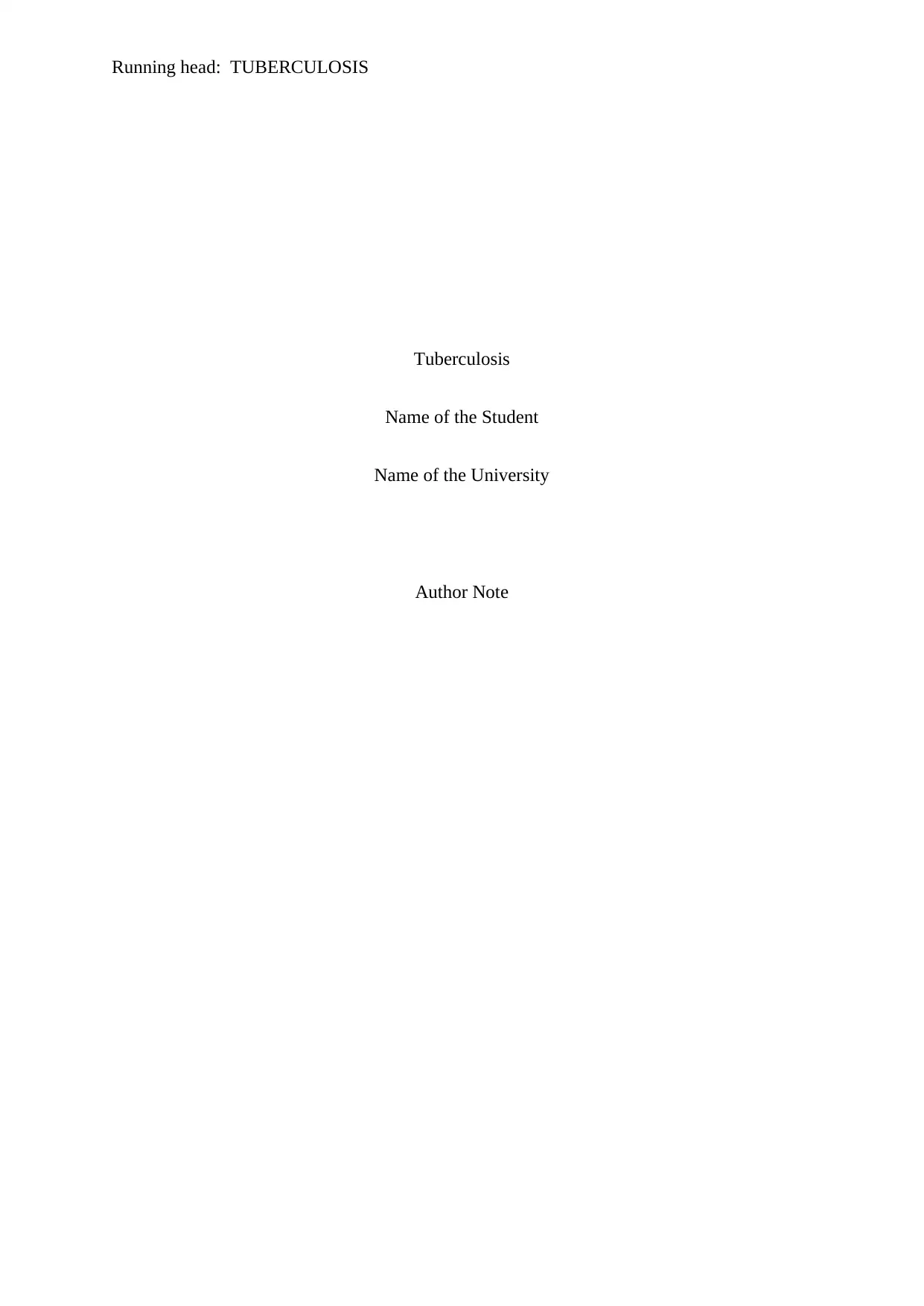
Running head: TUBERCULOSIS
Tuberculosis
Name of the Student
Name of the University
Author Note
Tuberculosis
Name of the Student
Name of the University
Author Note
Secure Best Marks with AI Grader
Need help grading? Try our AI Grader for instant feedback on your assignments.
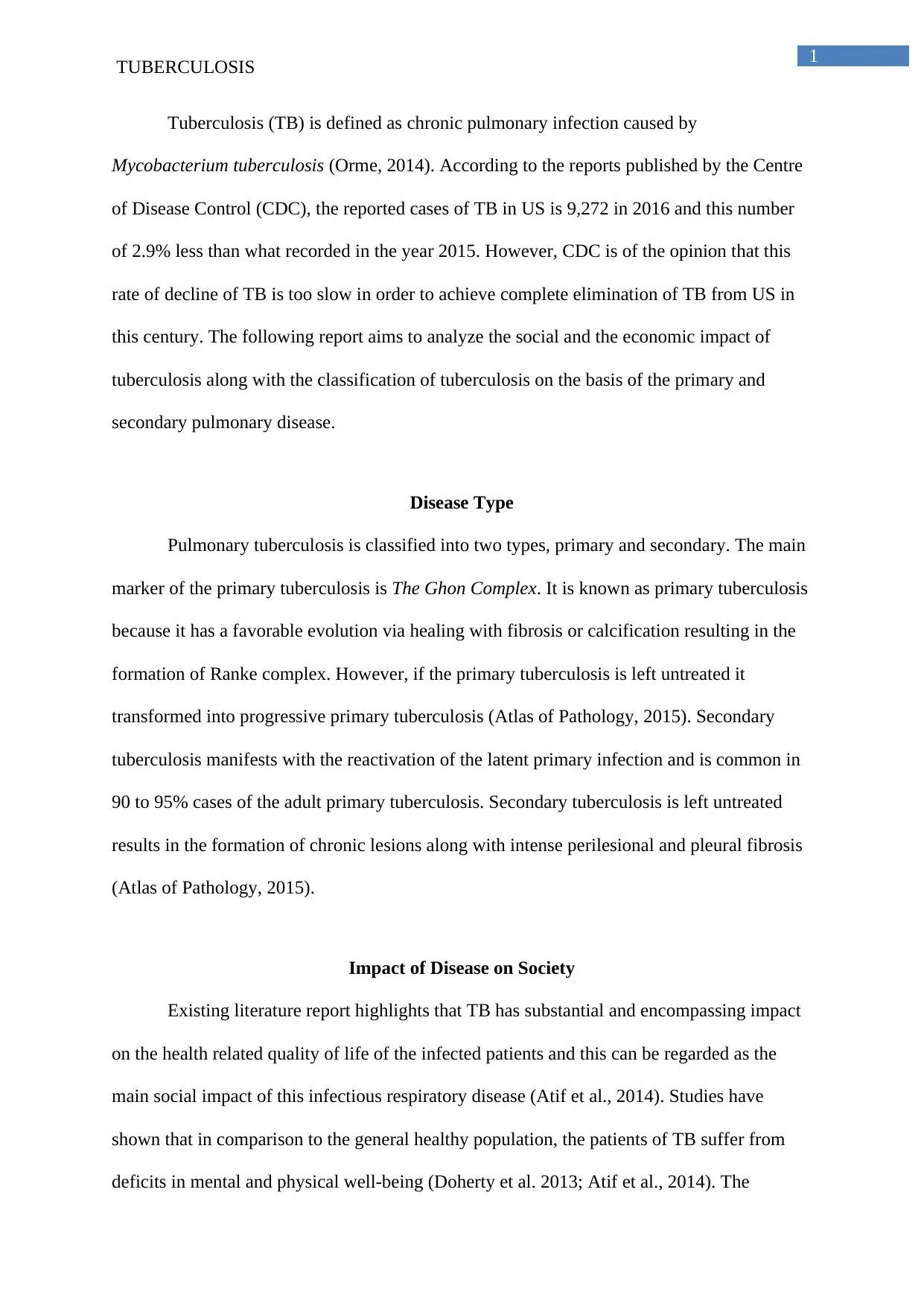
1
TUBERCULOSIS
Tuberculosis (TB) is defined as chronic pulmonary infection caused by
Mycobacterium tuberculosis (Orme, 2014). According to the reports published by the Centre
of Disease Control (CDC), the reported cases of TB in US is 9,272 in 2016 and this number
of 2.9% less than what recorded in the year 2015. However, CDC is of the opinion that this
rate of decline of TB is too slow in order to achieve complete elimination of TB from US in
this century. The following report aims to analyze the social and the economic impact of
tuberculosis along with the classification of tuberculosis on the basis of the primary and
secondary pulmonary disease.
Disease Type
Pulmonary tuberculosis is classified into two types, primary and secondary. The main
marker of the primary tuberculosis is The Ghon Complex. It is known as primary tuberculosis
because it has a favorable evolution via healing with fibrosis or calcification resulting in the
formation of Ranke complex. However, if the primary tuberculosis is left untreated it
transformed into progressive primary tuberculosis (Atlas of Pathology, 2015). Secondary
tuberculosis manifests with the reactivation of the latent primary infection and is common in
90 to 95% cases of the adult primary tuberculosis. Secondary tuberculosis is left untreated
results in the formation of chronic lesions along with intense perilesional and pleural fibrosis
(Atlas of Pathology, 2015).
Impact of Disease on Society
Existing literature report highlights that TB has substantial and encompassing impact
on the health related quality of life of the infected patients and this can be regarded as the
main social impact of this infectious respiratory disease (Atif et al., 2014). Studies have
shown that in comparison to the general healthy population, the patients of TB suffer from
deficits in mental and physical well-being (Doherty et al. 2013; Atif et al., 2014). The
TUBERCULOSIS
Tuberculosis (TB) is defined as chronic pulmonary infection caused by
Mycobacterium tuberculosis (Orme, 2014). According to the reports published by the Centre
of Disease Control (CDC), the reported cases of TB in US is 9,272 in 2016 and this number
of 2.9% less than what recorded in the year 2015. However, CDC is of the opinion that this
rate of decline of TB is too slow in order to achieve complete elimination of TB from US in
this century. The following report aims to analyze the social and the economic impact of
tuberculosis along with the classification of tuberculosis on the basis of the primary and
secondary pulmonary disease.
Disease Type
Pulmonary tuberculosis is classified into two types, primary and secondary. The main
marker of the primary tuberculosis is The Ghon Complex. It is known as primary tuberculosis
because it has a favorable evolution via healing with fibrosis or calcification resulting in the
formation of Ranke complex. However, if the primary tuberculosis is left untreated it
transformed into progressive primary tuberculosis (Atlas of Pathology, 2015). Secondary
tuberculosis manifests with the reactivation of the latent primary infection and is common in
90 to 95% cases of the adult primary tuberculosis. Secondary tuberculosis is left untreated
results in the formation of chronic lesions along with intense perilesional and pleural fibrosis
(Atlas of Pathology, 2015).
Impact of Disease on Society
Existing literature report highlights that TB has substantial and encompassing impact
on the health related quality of life of the infected patients and this can be regarded as the
main social impact of this infectious respiratory disease (Atif et al., 2014). Studies have
shown that in comparison to the general healthy population, the patients of TB suffer from
deficits in mental and physical well-being (Doherty et al. 2013; Atif et al., 2014). The
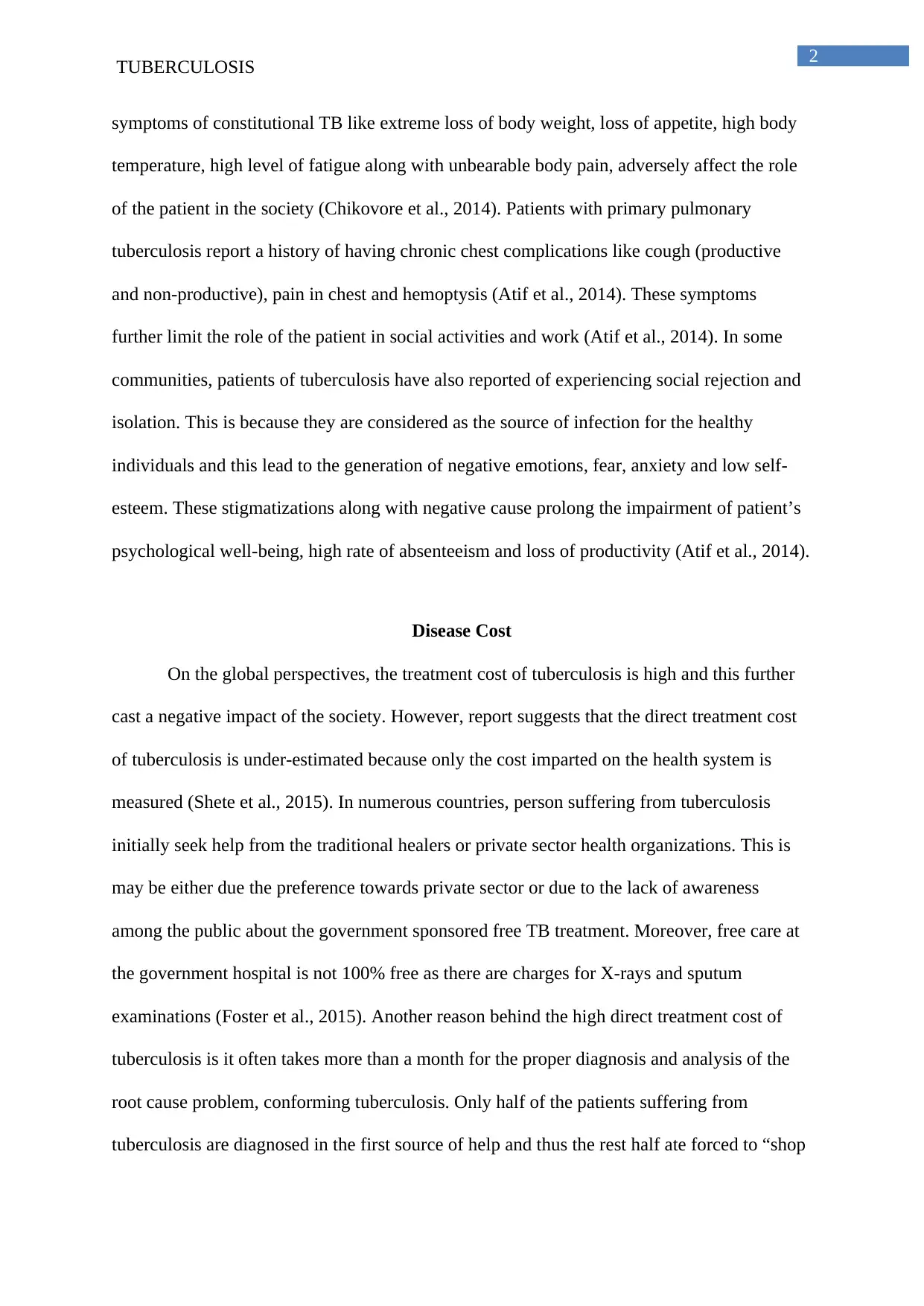
2
TUBERCULOSIS
symptoms of constitutional TB like extreme loss of body weight, loss of appetite, high body
temperature, high level of fatigue along with unbearable body pain, adversely affect the role
of the patient in the society (Chikovore et al., 2014). Patients with primary pulmonary
tuberculosis report a history of having chronic chest complications like cough (productive
and non-productive), pain in chest and hemoptysis (Atif et al., 2014). These symptoms
further limit the role of the patient in social activities and work (Atif et al., 2014). In some
communities, patients of tuberculosis have also reported of experiencing social rejection and
isolation. This is because they are considered as the source of infection for the healthy
individuals and this lead to the generation of negative emotions, fear, anxiety and low self-
esteem. These stigmatizations along with negative cause prolong the impairment of patient’s
psychological well-being, high rate of absenteeism and loss of productivity (Atif et al., 2014).
Disease Cost
On the global perspectives, the treatment cost of tuberculosis is high and this further
cast a negative impact of the society. However, report suggests that the direct treatment cost
of tuberculosis is under-estimated because only the cost imparted on the health system is
measured (Shete et al., 2015). In numerous countries, person suffering from tuberculosis
initially seek help from the traditional healers or private sector health organizations. This is
may be either due the preference towards private sector or due to the lack of awareness
among the public about the government sponsored free TB treatment. Moreover, free care at
the government hospital is not 100% free as there are charges for X-rays and sputum
examinations (Foster et al., 2015). Another reason behind the high direct treatment cost of
tuberculosis is it often takes more than a month for the proper diagnosis and analysis of the
root cause problem, conforming tuberculosis. Only half of the patients suffering from
tuberculosis are diagnosed in the first source of help and thus the rest half ate forced to “shop
TUBERCULOSIS
symptoms of constitutional TB like extreme loss of body weight, loss of appetite, high body
temperature, high level of fatigue along with unbearable body pain, adversely affect the role
of the patient in the society (Chikovore et al., 2014). Patients with primary pulmonary
tuberculosis report a history of having chronic chest complications like cough (productive
and non-productive), pain in chest and hemoptysis (Atif et al., 2014). These symptoms
further limit the role of the patient in social activities and work (Atif et al., 2014). In some
communities, patients of tuberculosis have also reported of experiencing social rejection and
isolation. This is because they are considered as the source of infection for the healthy
individuals and this lead to the generation of negative emotions, fear, anxiety and low self-
esteem. These stigmatizations along with negative cause prolong the impairment of patient’s
psychological well-being, high rate of absenteeism and loss of productivity (Atif et al., 2014).
Disease Cost
On the global perspectives, the treatment cost of tuberculosis is high and this further
cast a negative impact of the society. However, report suggests that the direct treatment cost
of tuberculosis is under-estimated because only the cost imparted on the health system is
measured (Shete et al., 2015). In numerous countries, person suffering from tuberculosis
initially seek help from the traditional healers or private sector health organizations. This is
may be either due the preference towards private sector or due to the lack of awareness
among the public about the government sponsored free TB treatment. Moreover, free care at
the government hospital is not 100% free as there are charges for X-rays and sputum
examinations (Foster et al., 2015). Another reason behind the high direct treatment cost of
tuberculosis is it often takes more than a month for the proper diagnosis and analysis of the
root cause problem, conforming tuberculosis. Only half of the patients suffering from
tuberculosis are diagnosed in the first source of help and thus the rest half ate forced to “shop
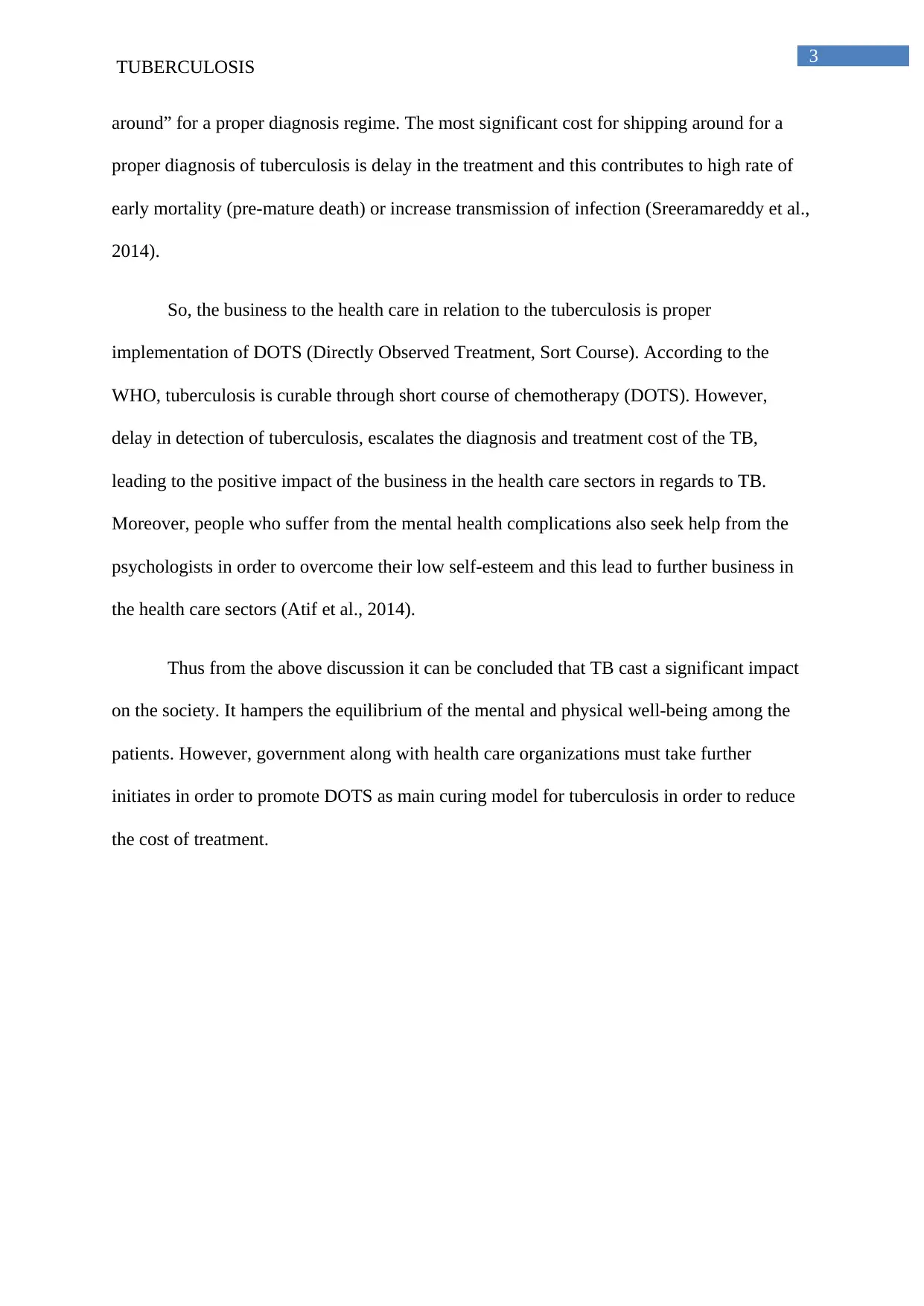
3
TUBERCULOSIS
around” for a proper diagnosis regime. The most significant cost for shipping around for a
proper diagnosis of tuberculosis is delay in the treatment and this contributes to high rate of
early mortality (pre-mature death) or increase transmission of infection (Sreeramareddy et al.,
2014).
So, the business to the health care in relation to the tuberculosis is proper
implementation of DOTS (Directly Observed Treatment, Sort Course). According to the
WHO, tuberculosis is curable through short course of chemotherapy (DOTS). However,
delay in detection of tuberculosis, escalates the diagnosis and treatment cost of the TB,
leading to the positive impact of the business in the health care sectors in regards to TB.
Moreover, people who suffer from the mental health complications also seek help from the
psychologists in order to overcome their low self-esteem and this lead to further business in
the health care sectors (Atif et al., 2014).
Thus from the above discussion it can be concluded that TB cast a significant impact
on the society. It hampers the equilibrium of the mental and physical well-being among the
patients. However, government along with health care organizations must take further
initiates in order to promote DOTS as main curing model for tuberculosis in order to reduce
the cost of treatment.
TUBERCULOSIS
around” for a proper diagnosis regime. The most significant cost for shipping around for a
proper diagnosis of tuberculosis is delay in the treatment and this contributes to high rate of
early mortality (pre-mature death) or increase transmission of infection (Sreeramareddy et al.,
2014).
So, the business to the health care in relation to the tuberculosis is proper
implementation of DOTS (Directly Observed Treatment, Sort Course). According to the
WHO, tuberculosis is curable through short course of chemotherapy (DOTS). However,
delay in detection of tuberculosis, escalates the diagnosis and treatment cost of the TB,
leading to the positive impact of the business in the health care sectors in regards to TB.
Moreover, people who suffer from the mental health complications also seek help from the
psychologists in order to overcome their low self-esteem and this lead to further business in
the health care sectors (Atif et al., 2014).
Thus from the above discussion it can be concluded that TB cast a significant impact
on the society. It hampers the equilibrium of the mental and physical well-being among the
patients. However, government along with health care organizations must take further
initiates in order to promote DOTS as main curing model for tuberculosis in order to reduce
the cost of treatment.
Secure Best Marks with AI Grader
Need help grading? Try our AI Grader for instant feedback on your assignments.
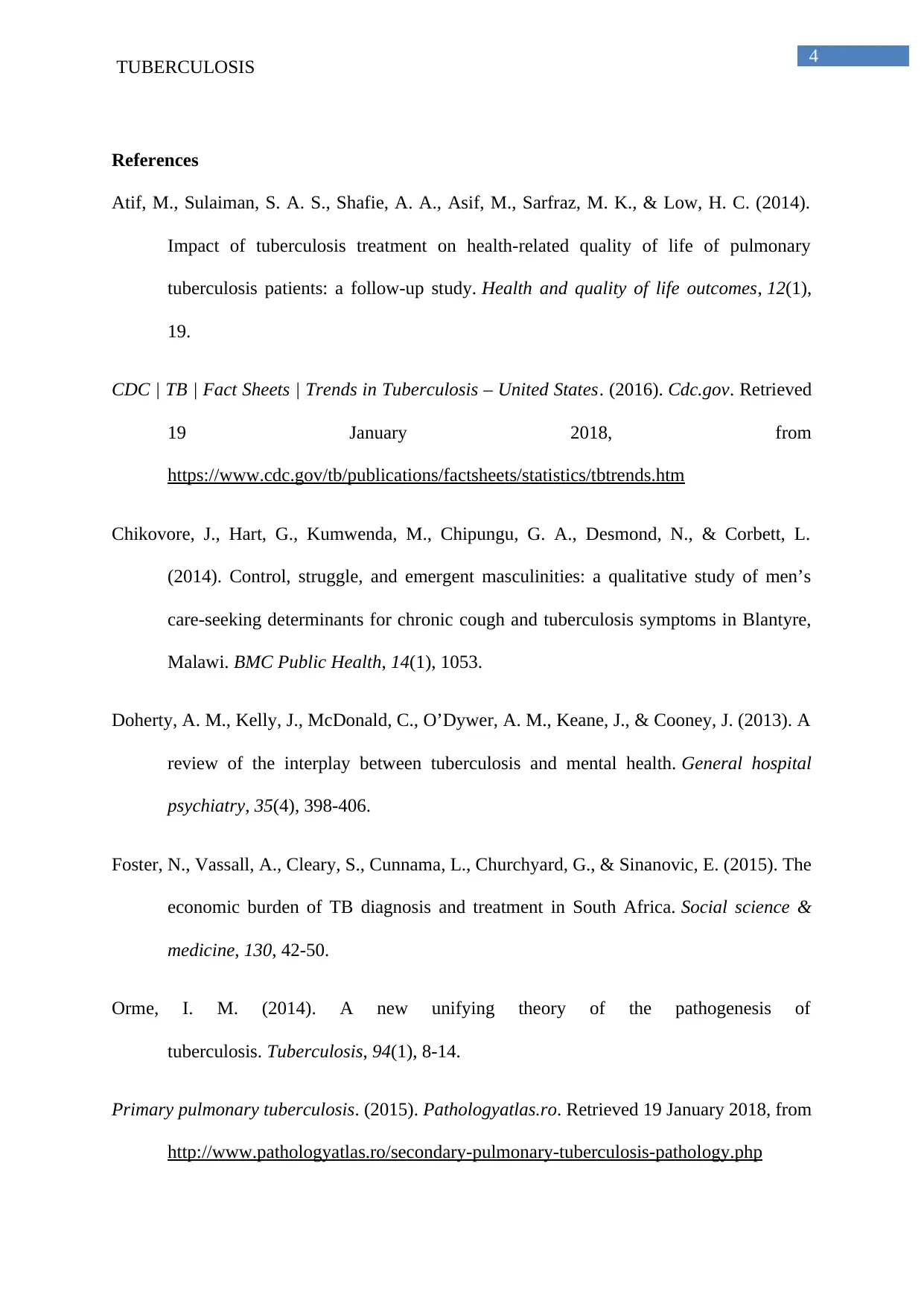
4
TUBERCULOSIS
References
Atif, M., Sulaiman, S. A. S., Shafie, A. A., Asif, M., Sarfraz, M. K., & Low, H. C. (2014).
Impact of tuberculosis treatment on health-related quality of life of pulmonary
tuberculosis patients: a follow-up study. Health and quality of life outcomes, 12(1),
19.
CDC | TB | Fact Sheets | Trends in Tuberculosis – United States. (2016). Cdc.gov. Retrieved
19 January 2018, from
https://www.cdc.gov/tb/publications/factsheets/statistics/tbtrends.htm
Chikovore, J., Hart, G., Kumwenda, M., Chipungu, G. A., Desmond, N., & Corbett, L.
(2014). Control, struggle, and emergent masculinities: a qualitative study of men’s
care-seeking determinants for chronic cough and tuberculosis symptoms in Blantyre,
Malawi. BMC Public Health, 14(1), 1053.
Doherty, A. M., Kelly, J., McDonald, C., O’Dywer, A. M., Keane, J., & Cooney, J. (2013). A
review of the interplay between tuberculosis and mental health. General hospital
psychiatry, 35(4), 398-406.
Foster, N., Vassall, A., Cleary, S., Cunnama, L., Churchyard, G., & Sinanovic, E. (2015). The
economic burden of TB diagnosis and treatment in South Africa. Social science &
medicine, 130, 42-50.
Orme, I. M. (2014). A new unifying theory of the pathogenesis of
tuberculosis. Tuberculosis, 94(1), 8-14.
Primary pulmonary tuberculosis. (2015). Pathologyatlas.ro. Retrieved 19 January 2018, from
http://www.pathologyatlas.ro/secondary-pulmonary-tuberculosis-pathology.php
TUBERCULOSIS
References
Atif, M., Sulaiman, S. A. S., Shafie, A. A., Asif, M., Sarfraz, M. K., & Low, H. C. (2014).
Impact of tuberculosis treatment on health-related quality of life of pulmonary
tuberculosis patients: a follow-up study. Health and quality of life outcomes, 12(1),
19.
CDC | TB | Fact Sheets | Trends in Tuberculosis – United States. (2016). Cdc.gov. Retrieved
19 January 2018, from
https://www.cdc.gov/tb/publications/factsheets/statistics/tbtrends.htm
Chikovore, J., Hart, G., Kumwenda, M., Chipungu, G. A., Desmond, N., & Corbett, L.
(2014). Control, struggle, and emergent masculinities: a qualitative study of men’s
care-seeking determinants for chronic cough and tuberculosis symptoms in Blantyre,
Malawi. BMC Public Health, 14(1), 1053.
Doherty, A. M., Kelly, J., McDonald, C., O’Dywer, A. M., Keane, J., & Cooney, J. (2013). A
review of the interplay between tuberculosis and mental health. General hospital
psychiatry, 35(4), 398-406.
Foster, N., Vassall, A., Cleary, S., Cunnama, L., Churchyard, G., & Sinanovic, E. (2015). The
economic burden of TB diagnosis and treatment in South Africa. Social science &
medicine, 130, 42-50.
Orme, I. M. (2014). A new unifying theory of the pathogenesis of
tuberculosis. Tuberculosis, 94(1), 8-14.
Primary pulmonary tuberculosis. (2015). Pathologyatlas.ro. Retrieved 19 January 2018, from
http://www.pathologyatlas.ro/secondary-pulmonary-tuberculosis-pathology.php
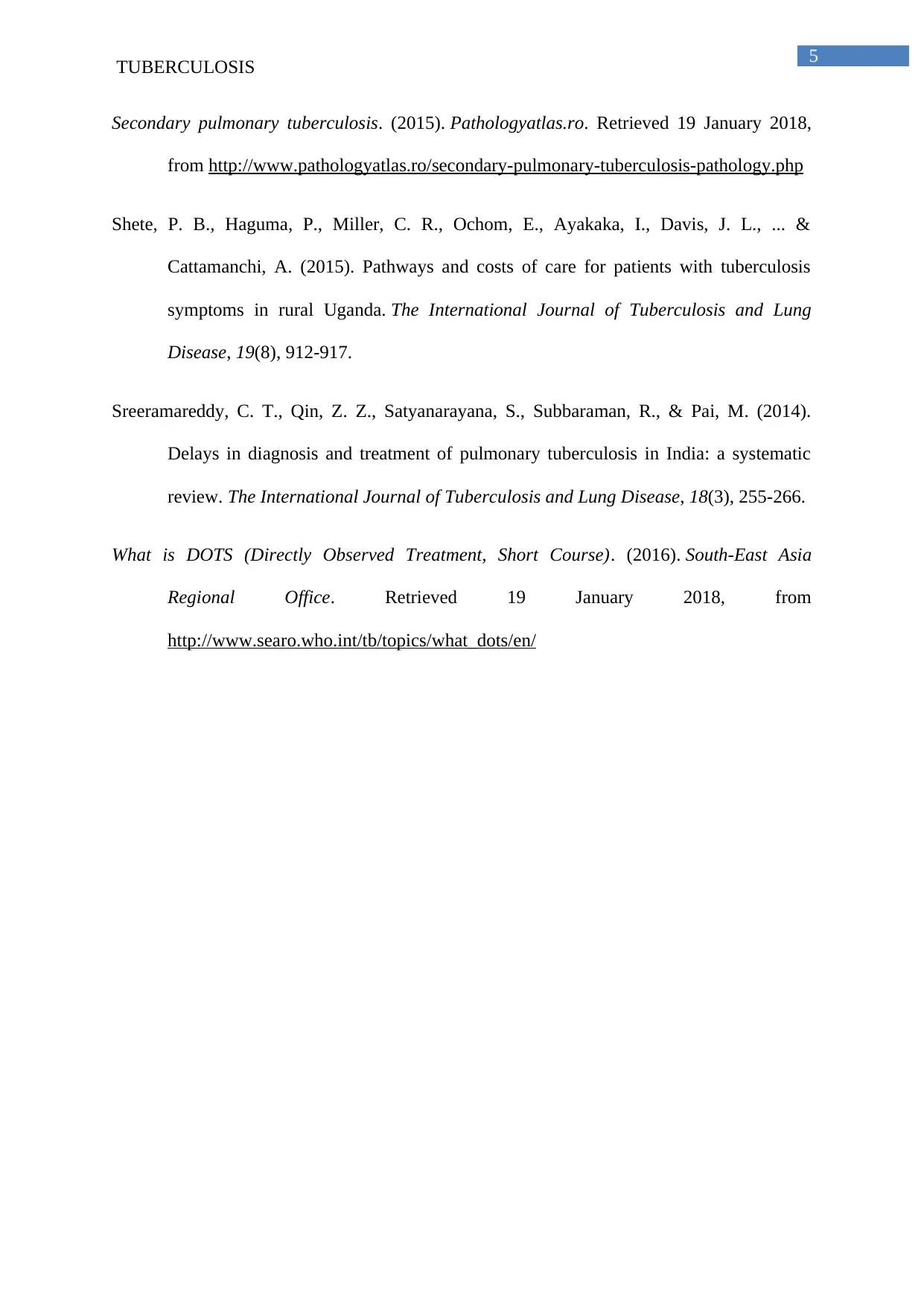
5
TUBERCULOSIS
Secondary pulmonary tuberculosis. (2015). Pathologyatlas.ro. Retrieved 19 January 2018,
from http://www.pathologyatlas.ro/secondary-pulmonary-tuberculosis-pathology.php
Shete, P. B., Haguma, P., Miller, C. R., Ochom, E., Ayakaka, I., Davis, J. L., ... &
Cattamanchi, A. (2015). Pathways and costs of care for patients with tuberculosis
symptoms in rural Uganda. The International Journal of Tuberculosis and Lung
Disease, 19(8), 912-917.
Sreeramareddy, C. T., Qin, Z. Z., Satyanarayana, S., Subbaraman, R., & Pai, M. (2014).
Delays in diagnosis and treatment of pulmonary tuberculosis in India: a systematic
review. The International Journal of Tuberculosis and Lung Disease, 18(3), 255-266.
What is DOTS (Directly Observed Treatment, Short Course). (2016). South-East Asia
Regional Office. Retrieved 19 January 2018, from
http://www.searo.who.int/tb/topics/what_dots/en/
TUBERCULOSIS
Secondary pulmonary tuberculosis. (2015). Pathologyatlas.ro. Retrieved 19 January 2018,
from http://www.pathologyatlas.ro/secondary-pulmonary-tuberculosis-pathology.php
Shete, P. B., Haguma, P., Miller, C. R., Ochom, E., Ayakaka, I., Davis, J. L., ... &
Cattamanchi, A. (2015). Pathways and costs of care for patients with tuberculosis
symptoms in rural Uganda. The International Journal of Tuberculosis and Lung
Disease, 19(8), 912-917.
Sreeramareddy, C. T., Qin, Z. Z., Satyanarayana, S., Subbaraman, R., & Pai, M. (2014).
Delays in diagnosis and treatment of pulmonary tuberculosis in India: a systematic
review. The International Journal of Tuberculosis and Lung Disease, 18(3), 255-266.
What is DOTS (Directly Observed Treatment, Short Course). (2016). South-East Asia
Regional Office. Retrieved 19 January 2018, from
http://www.searo.who.int/tb/topics/what_dots/en/
1 out of 6
Related Documents
Your All-in-One AI-Powered Toolkit for Academic Success.
+13062052269
info@desklib.com
Available 24*7 on WhatsApp / Email
![[object Object]](/_next/static/media/star-bottom.7253800d.svg)
Unlock your academic potential
© 2024 | Zucol Services PVT LTD | All rights reserved.





